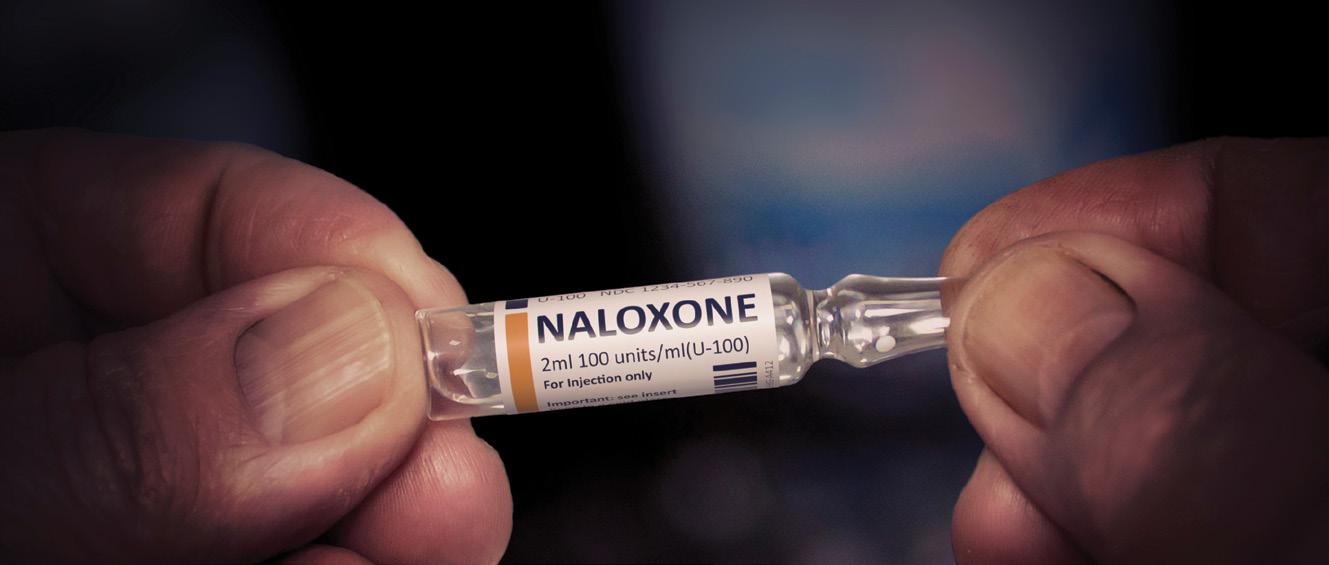
4 minute read
Naloxone - The “Pay It Forward” Medication
Naloxone
The “Pay It Forward” Medication
by Dr. William Santoro
Naloxone is a life-saving medication that can reverse an overdose from opioids including heroin, fentanyl, and prescription opioid medications. Its effects begin within two request a naloxone kit. In Berks County any citizen who cannot afford the cost of a naloxone kit can contact the Counsel on Chemical Abuse (COCA) and be given help in getting a naloxone kit minutes when given nasally or intravenously and within five minutes when injected intramuscularly. Because of the speed of onset, the ease of administration and lack of needle needed, it is often given as a nasal spray. The effects of naloxone last from about 30 seconds to 24 hours with an average of about 15 minutes. Multiple doses may be required, as the duration of action of most opioids is greater than that of naloxone.
Finding drugs to counter the addictive and potentially fatal use of heroin, morphine and other narcotics was an area of increasing research in the late 1950s and early 1960s. While some solutions were found to be somewhat effective, they had strong and even dangerous side effects and could themselves cause addiction.
One researcher, Dr. Harold Blumberg of Endo Laboratories on Long Island, New York, concluded that a safer, more effective drug could be derived from a new synthesized form of morphine. At the time, Dr. Jack Fishman was on staff at the Sloan-Kettering Institute for Cancer Research and also worked at a private pharmaceutical lab run by Dr. Mozes J. Lewenstein. Dr. Fishman and Dr. Lewenstein helped figure out how to make the drug Dr. Blumberg had described. Tests showed the drug, naloxone, to be far more powerful and to pose far fewer side effects than its predecessors. Naloxone was patented in 1961 by Dr. Lewenstein and Dr. Fishman.
Naloxone was approved for treating opioid overdose in the United States in 1971. It is on the World Health Organization’s list of essential medicines. After its approval in the U.S. in 1971, opioid overdose prevention kits began being distributed by many states to medically untrained people beginning in 1996. The CDC estimates that Dr. Fishman’s discovery of naloxone reversed over 26,000 cases of opioid overdose between the years 1996 and 2014.
While paramedics have carried naloxone for decades, law enforcement officers in many states throughout the country now carry naloxone to reverse the effects of heroin overdoses when reaching the location before paramedics. As of July 12, 2015, law enforcement departments in 28 states are allowed to, or are required to, carry naloxone to quickly respond to opioid overdoses. In April 2021, the U.S. Food and Drug Administration (FDA) approved a higher dose of naloxone hydrochloride nasal spray product (Kloxxado) to treat opioid overdose.
Here in Pennsylvania, Dr. Rachel Levine, the state’s Physician General and Secretary of Health, issued a standing order for naloxone. A standing order is a prescription written for the general public. Any Pennsylvania citizen can walk into a pharmacy and free or at a cost that is affordable. A more personal history about this life-saving medication is far more interesting, and sad, than its pharmaceutical history. Jonathon Fishman, Dr. Jack Fishman’s stepson, was born in 1972, 11 years after his stepfather developed naloxone and 1 year after it was approved for use in the United States for opioid overdose. In the 1990s, Jonathan became addicted to heroin. Living in Florida, where the law still prohibits selling needles without a prescription and possessing them can result in charges for drug paraphernalia, he was arrested several times for stealing needles from pharmacies. He contracted Hepatitis C from sharing dirty needles. Then, in 2006, at age 34, Jonathon Fishman died of a heroin overdose. At the time of his stepson’s death, Dr. Jack Fishman was still unable to obtain the medication he helped invent that would have saved his son. Dr. Jack Fishman died on December 8, 2013, at his home in Remsenburg, N.Y., at the age of 83. Today many people believe that naloxone should be distributed to patients with an opioid use disorder so that they would have it on hand in case they were to overdose. This, however, is not the real use or distribution need of naloxone. In the sad event that a patient with opioid use disorder overdoses, that patient will be unable to administer to themselves the life-saving medication naloxone. It is my opinion, and the opinion of many other physicians, that every person has access to naloxone. While the medication will never be administered by the patient overdosing, it can be administered to a patient who is overdosing by a loved one, friend or perfect stranger. In the end naloxone is primarily a “pay it forward” medication. And I believe in my heart that Dr. Jack Fishman would be very supportive of this “pay it forward” mentality. Please consider obtaining a naloxone kit and safely storing it where it would be readily available to be used in the case of an emergency. Storing it at home in the closet will not do anyone any good while it would likely be needed when one is simply traveling to a department store or convenience store. Naloxone kits are small enough to store in a car’s glove compartment. To protect it from extreme temperature changes, it should be placed in an inexpensive thermal envelope. The inhalation device itself is small enough to be carried in a woman’s pocketbook or purse. Obtain naloxone, learn how to easily use it, keep it handy and use it when needed. The life you save will certainly be someone’s child. Do it in honor of Jonathon.









